Hygrothermal Performance Analysis of Wooden Basements under Critical Conditions
Abstract
1. Introduction
| Author | Load-Bearing Material Used in the Basement | Main Objective | Main Outcome |
|---|---|---|---|
| Maref et al. (2001) [16] | Concrete | Analysis of the thermal resistance of exterior basement insulation systems by developing a three-dimensional numerical model verified using experimental measurements. | The utilization of the 3D model demonstrated an improved ability to evaluate the long-term thermal resistance of the insulation systems employed in the research. |
| Swinton et al. (2006) [17] | Concrete | Study of the actual thermal performance of two concrete basement walls. | The thermal performance remained consistently stable, with either equivalent or improved performance observed in the second heating season. |
| Emery et al. (2007) [18] | Concrete | Comparison of the insulated and non-insulated basements through a series of measurements. | A modest amount of insulation could lead to a significant reduction in annual heat loss, approximately by 50%. |
| Künzel et al. (2008) [6] | Concrete | Investigation of the moisture dynamics of concrete cellar walls with interior insulation. | Internal drying potential increases notably when using a moisture-adaptive vapor barrier. |
| Straube (2009) [7] | Concrete | Study of the hygrothermal performance of concrete basement walls with different interior insulation systems. | There was a discrepancy between simulations and measurements, possibly due to factors such as air leakage, vapor diffusion, and other variables. |
| Saber et al. (2012) [19] | Concrete | Study of the thermal response of basement wall systems with low-emissivity material and furred airspace. | The wall with a furred-airspace assembly could yield energy savings of approximately 17% in comparison with walls lacking the furred airspaces. |
| Pallin (2013) [8] | Concrete | Hygrothermal simulations of a concrete basement wall with a focus on investigating the impacts of outward drying. | If there is a favorable drying condition, only a minimal amount of precipitation would penetrate the insulation or drainage board. |
| Goldberg and Harmon (2015) [9] | Masonry block | Evaluation of the hygrothermal performance of retrofitted hollow masonry block foundations with thermal insulation in cold-climate conditions. | The differences in wall temperature between the measured and simulated data decreased with increasing distance from the foundation slab. |
| Fedorik et al. (2019) [10] | Concrete | Simulation of the hygrothermal conditions inside three concrete basement walls built in different decades. | Using capillary-active materials to enable inward drying is an effective solution for retrofitting. |
| Asphaug et al. (2020) [11] | Concrete | Identification of ten key challenges essential for inclusion in national moisture control strategies for habitable basements in cold-climate Western regions. | The ten key challenges are emphasized differently across the five cold-climate countries despite notable similarities in recommendations. |
| Saaly et al. (2020) [20] | Concrete | Study of the effects of freeze-thaw cycles on the heat transfer properties of a concrete basement. | Adding insulation layers to the basement walls and floor slab resulted in a significant reduction of approximately 60% in energy loss. |
| Asphaug et al. (2021) [12] | Concrete | Review of the latest state-of-the-art methodologies to specify exterior hygrothermal boundary conditions for hygrothermal simulation of below-grade basement structures. | The review highlighted the lack of thorough validation of hygrothermal simulations and the inadequacy of hygrothermal simulation tools to replicate real-world hygrothermal conditions in basement envelopes accurately. |
| Asphaug et al. (2022a) [13] | Concrete | Experiments study to see the impact of the permeability of thermal insulation and the position of the dimpled membrane on the outward drying process of concrete walls. | The concrete’s ability to transport moisture to the drying surface was more important than the vapor permeability of the insulation and the membrane position. |
| Asphaug et al. (2022b) [14] | Concrete | Numerical simulations to evaluate the use of vapor-permeable thermal insulation and the impact of air gaps behind dimple membranes on the outward drying of concrete basement walls | In addition to the position of the membrane, the interior relative humidity (RH) is influenced by both the thickness of insulation used in the wall assembly and the characteristics of the concrete. |
| Rahiminejad et al. (2024) [15] | Wood | Long-term performance analysis of a wooden basement using in-field measurements and numerical simulations. | The applicability and reliability of long-term use of wooden elements in the basement structure. |
2. Methodology
2.1. Reference Building
2.1.1. Layout
2.1.2. Data Monitored
2.2. Research Procedure
2.3. Assessment Criterion
2.4. Scenarios Simulated
2.4.1. One-Dimensional Model
2.4.2. Two-Dimensional Model
2.5. Model Preparation
2.5.1. Geometry and Mesh Generation
2.5.2. Material Properties
2.6. Simulation Setup
2.6.1. Initial Conditions
2.6.2. Boundary Conditions
One-Dimensional Model
Two-Dimensional Model
2.7. Computational Parameters
3. Results
3.1. One-Dimensional Model with Actual Assembly
3.1.1. Heated Space
3.1.2. Unheated Space
3.2. One-Dimensional Model with Thin Assembly
3.2.1. Heated Space
3.2.2. Unheated Space
3.3. Two-Dimensional Model with Actual Assembly
3.4. Two-Dimensional Model with Thin Assembly
4. Discussion
5. Conclusions
Author Contributions
Funding
Data Availability Statement
Acknowledgments
Conflicts of Interest
Appendix A. Effective Hygrothermal Properties of Air in an Unventilated Air Layer
References
- Goto, Y.; Wakili, K.G.; Frank, T.; Stahl, T.; Ostermeyer, Y.; Ando, N.; Wallbaum, H. Heat and moisture balance simulation of a building with vapor-open envelope system for subtropical regions. Build. Simul. 2012, 5, 301–314. [Google Scholar] [CrossRef]
- Ueno, K. Hygrothermal Behavior of Interior Basement Insulation; University of Waterloo: Waterloo, ON, Canada, 2007. [Google Scholar]
- Allwood, J.; Azevedo, J.; Clare, A.; Cleaver, C.; Cullen, J.; Dunant, C.; Fellin, T.; Hawkins, W.; Horrocks, I.; Horton, P.; et al. Absolute Zero: Delivering the UK’s Climate Change Commitment with Incremental Changes to Today’s Technologies; University of Cambridge: Cambridge, UK, 2019. [Google Scholar]
- Olsson, J.A.; Miller, S.A.; Alexander, M.G. Near-term pathways for decarbonizing global concrete production. Nat. Commun. 2023, 14, 4574. [Google Scholar] [CrossRef] [PubMed]
- Zabel, R.A.; Morrell, J.J. (Eds.) Wood Microbiology, 2nd ed.; Elsevier: Amsterdam, The Netherlands, 2020. [Google Scholar]
- Künzel, H.M.; Zirkelbach, D.; Bludau, C. Feuchteverhalten von Kellerwänden mit Innendämmung. Z. Für Wärmeschutz Kälteschutz Schallschutz Brandschutz 2008, 60, 17–24. [Google Scholar]
- Straube, J. Field Monitoring Hygrothermal Modeling Basement Insulation; Research Report 0906; Building Science Press: Westford, MA, USA, 2009. [Google Scholar]
- Pallin, S. Risk Assessment of Hygrothermal Performance: Building Envelope Retrofit; Chalmers University of Technology: Göteborg, Sweden, 2013. [Google Scholar]
- Goldberg, L.F.; Harmon, A.C. Cold Climate Foundation Retrofit Experimental Hygrothermal Performance: Cloquet Residential Research Facility Laboratory Results; National Renewable Energy Laboratory: Golden, CO, USA, 2015; 248p. [Google Scholar]
- Fedorik, F.; Heiskanen, R.; Laukkarinen, A.; Vinha, J. Impacts of multiple refurbishment strategies on hygrothermal behaviour of basement walls. J. Build. Eng. 2019, 26, 100902. [Google Scholar] [CrossRef]
- Asphaug, S.K.; Kvande, T.; Time, B.; Peuhkuri, R.H.; Kalamees, T.; Johansson, P.; Berardi, U.; Lohne, J. Moisture control strategies of habitable basements in cold climates. Build. Environ. 2020, 169, 106572. [Google Scholar] [CrossRef]
- Asphaug, S.K.; Time, B.; Kvande, T. Hygrothermal simulations of thermally insulated basement envelopes—Importance of boundary conditions below grade. Build. Environ. 2021, 199, 107920. [Google Scholar] [CrossRef]
- Asphaug, S.; Hjermann, I.; Time, B.; Kvande, T. Monitoring outward drying of externally insulated basement walls: A laboratory experiment. Build. Environ. 2022, 217, 109097. [Google Scholar] [CrossRef]
- Asphaug, S.K.; Andenæs, E.; Geving, S.; Time, B.; Kvande, T. Moisture-resilient performance of concrete basement walls: Numerical simulations of the effect of outward drying. Build. Environ. 2022, 222, 109393. [Google Scholar] [CrossRef]
- Rahiminejad, M.; Raeber, V.; Wakili, K.G.; Geyer, C.; Zoelig, S.; Renfer, C. Wooden basement; Hygrothermal performance analysis using in-field measurements and numerical simulations. Build. Environ. 2024, 256, 111475. [Google Scholar] [CrossRef]
- Maref, W.; Swinton, M.C.; Kumaran, M.K.; Bomberg, M.T. Three-dimensional analysis of thermal resistance of exterior basement insulation systems (EIBS). Build. Environ. 2001, 36, 407–419. [Google Scholar] [CrossRef][Green Version]
- Swinton, M.C.; Maref, W.; Bomberg, M.T.; Kumaran, M.K.; Normandin, N. In situ performance evaluation of spray polyurethane foam in the exterior insulation basement system (EIBS). Build. Environ. 2006, 41, 1872–1880. [Google Scholar] [CrossRef]
- Emery, A.F.; Heerwagen, D.R.; Kippenhan, C.J.; Steele, D.E. Measured and predicted thermal performance of a residential basement. HVACR Res. 2007, 13, 39–57. [Google Scholar] [CrossRef]
- Saber, H.H.; Maref, W.; Swinton, M.C. Thermal response of basement wall systems with low-emissivity material and furred airspace. J. Build. Phys. 2012, 35, 353–371. [Google Scholar] [CrossRef]
- Saaly, M.; Bobko, K.; Maghoul, P.; Kavgic, M.; Holländer, H. Energy performance of below-grade envelope of an institutional building in cold regions. J. Build. Eng. 2020, 27, 100911. [Google Scholar] [CrossRef]
- MeteoSwiss; Federal Office of Meteorology and Climatology, IDAWEB Portal. Available online: https://gate.meteoswiss.ch/idaweb/login.do (accessed on 27 September 2021).
- SIA 380/1; Heizwärmebedarf. Swiss Society of Engineers and Architects: Zürich, Switzerland, 2016.
- Kehl, D. (Ed.) Feuchtetechnische Bewertung von Holzbauteilen—Vereinfachte Nachweise und Simulation; WTA-Merkblatt 6-8; Frauenhofer IRB Verlag: Stuttgart, Germany, 2016. [Google Scholar]
- Zirkelbach, D. Hygrothermische Simulation—Anwendungsmöglichkeiten für Planer und Sachverständige; ISK 2013-12; Internationale Baufach—Und Sachverständigentagung Ausbau und Fassade: Regensburg, Germany, 2013. [Google Scholar]
- Kukk, V.; Kaljula, L.; Kers, J.; Kalamees, T. Designing highly insulated cross-laminated timber external walls in terms of hygrothermal performance: Field measurements and simulations. Build. Environ. 2022, 212, 108805. [Google Scholar] [CrossRef]
- Künzel, H.M. Modelling air leakage in hygrothermal envelope simulation. In Proceedings of the Building Enclosure Science & Technology (BEST3) Conference, Atlanta, GA, USA, 2 April 2012. [Google Scholar]
- Künzel, H.M. Simultaneous Heat and Moisture Transport in Building Components: One-and Two-Dimensional Calculation Using Simple Parameters; IRB-Verlag: Stuttgart, Germany, 1995; ISBN 3-8167-4103-7. [Google Scholar]
- McClung, R.; Ge, H.; Straube, J.; Wang, J. Hygrothermal performance of cross-laminated timber wall assemblies with built-in moisture: Field measurements and simulations. Build. Environ. 2014, 71, 95–110. [Google Scholar] [CrossRef]
- Lepage, R.; Finch, G. Moisture uptake testing for CLT floor panels in a tall wood building in Vancouver. In Proceedings of the 15th Canadian Conference on Building Science and Technology, Vancouver, BC, Canada, 6–8 November 2017. [Google Scholar]
- Schilliger Holz AG. Environmental Product Declaration as per ISO 14025 and EN 15804. Available online: https://www.schilliger.ch/wp-content/uploads/2020/09/2020.06.23-_-EPD-cross-laminated-timber-GFP-English-_-02.09.2020.pdf (accessed on 1 October 2020).
- Swisspor AG. Available online: https://www.swisspor.com/ch-de/swissporxps (accessed on 1 October 2023).
- Contec, A.G. Available online: https://www.contec.ch/de/Downloads?category=35 (accessed on 1 October 2023).
- H-GEOL AG. Geotechnical Preliminary Study; Demolition, Conversion, and Elevation of the Greenhouses. 2020. Available online: https://www.abageol.ch/ (accessed on 14 May 2024).
- Sonderegger, W.; Niemz, P. Thermal conductivity and water vapour transmission properties of wood-based materials. Eur. J. Wood Wood Prod. 2009, 67, 313–321. [Google Scholar] [CrossRef]
- Bader, H.; Niemz, P.; Sonderegger, W. Untersuchungen zum Einfluss des Plattenaufbaus auf ausgewählte Eigenschaften von Massivholzplatten. Holz Als Roh- Werkst. 2007, 65, 173–181. [Google Scholar] [CrossRef][Green Version]
- Bonifacio, S. Messungen und Simulation des Wassertransportes in Holzbauteilen; Bern University of Applied Sciences: Bern, Switzerland, 2020. [Google Scholar]
- EN ISO 12572; Hygrothermal Performance of Building Materials and Products—Determination of Water Vapour Transmission Properties—Cup Method. International Organization for Standardization (ISO): Geneva, Switzerland, 2016.
- EN 15026; Hygrothermal Performance of Building Components and Building Elements—Assessment of Moisture Transfer by Numerical Simulation. European Committee for Standardization (CEN): Brussels, Belgium, 2007.
- Künzel, H.M. Bedeutung von Klimabedingungen und Diffusionseigenschaften für die Feuchtesicherheit voll gedämmter Altbaudächer. In Bauphysik. Berichte aus Forschung und Praxis. Festschrift zum 60; Hauser, G., Ed.; Geburtstag von Karl Gertis Fraunhofer IRB Verlag: Stuttgart, Germany, 1998. [Google Scholar]
- Künzel, H.M. Raumluftfeuchte in Wohngebäuden—Randbedingung für die Feuchteschutzbeurteilung. Wksb—Zeitschrift für Wärmeschutz, Kälteschutz, Schallschutz. Brandschutz 2006, 51, 31–34. [Google Scholar]
- EN ISO 13370; Thermal Performance of Buildings-Heat Transfer via the Ground-Calculation Methods. International Organization for Standardization (ISO): Geneva, Switzerland, 2017.
- DIN 4108-3; Wärmeschutz und Energie-Einsparung in Gebäuden. Teil 3: Klimabedingter Feuchteschutz—Anforderungen, Berechnungsverfahren und Hinweise für Planung und Ausführung. Beuth Verlag: Berlin, Germany, 2014.
- EN ISO 10211; Thermal Bridges in Building Construction—Heat Flows and Surface Temperatures—Detailed Calculations. International Organization for Standardization (ISO): Geneva, Switzerland, 2017.
- Zürcher, C.; Frank, T. Bauphysik: Bau & Energie, 5th ed.; vdf Hochschulverlag AG: Zürich, Switzland, 2018. [Google Scholar]
- EN ISO 6946; Building Components and Building Elements, Thermal Resistance and Thermal Transmittance. Calculation Methods. International Organization for Standardization (ISO): Geneva, Switzerland, 2017.
- Schirmer, R. Die Diffusionszahl von Wasserdampf-Luft-Gemischen und die Verdampfungsgeschwindigkeit, Beiheft VDI-Zeitschrift. Verfahrenstechnik 1938, 6, 170–177. [Google Scholar]
- Illig, W. Die Größe der Wasserdampfübergangszahl bei Diffusionsvorgängen in Wänden von Wohnungen, Stallungen und Kühlräumen. Gesundheitsingenieur 1952, 73, 124–127. [Google Scholar]
- Gösele, K.; Schüle, W. Schall·Wärme·Feuchte; Bauverlag: Gütersloh, Germany, 1989. [Google Scholar]

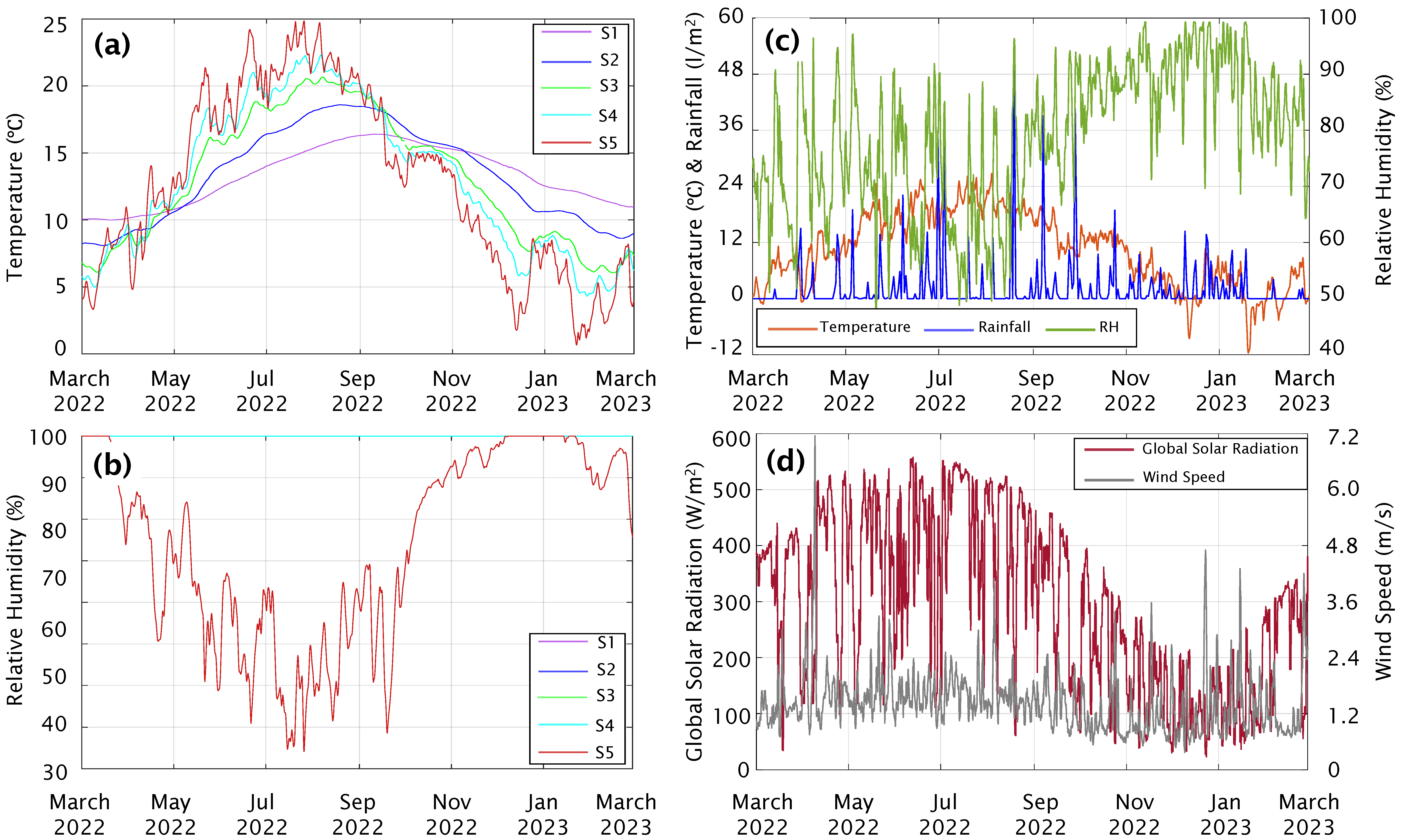

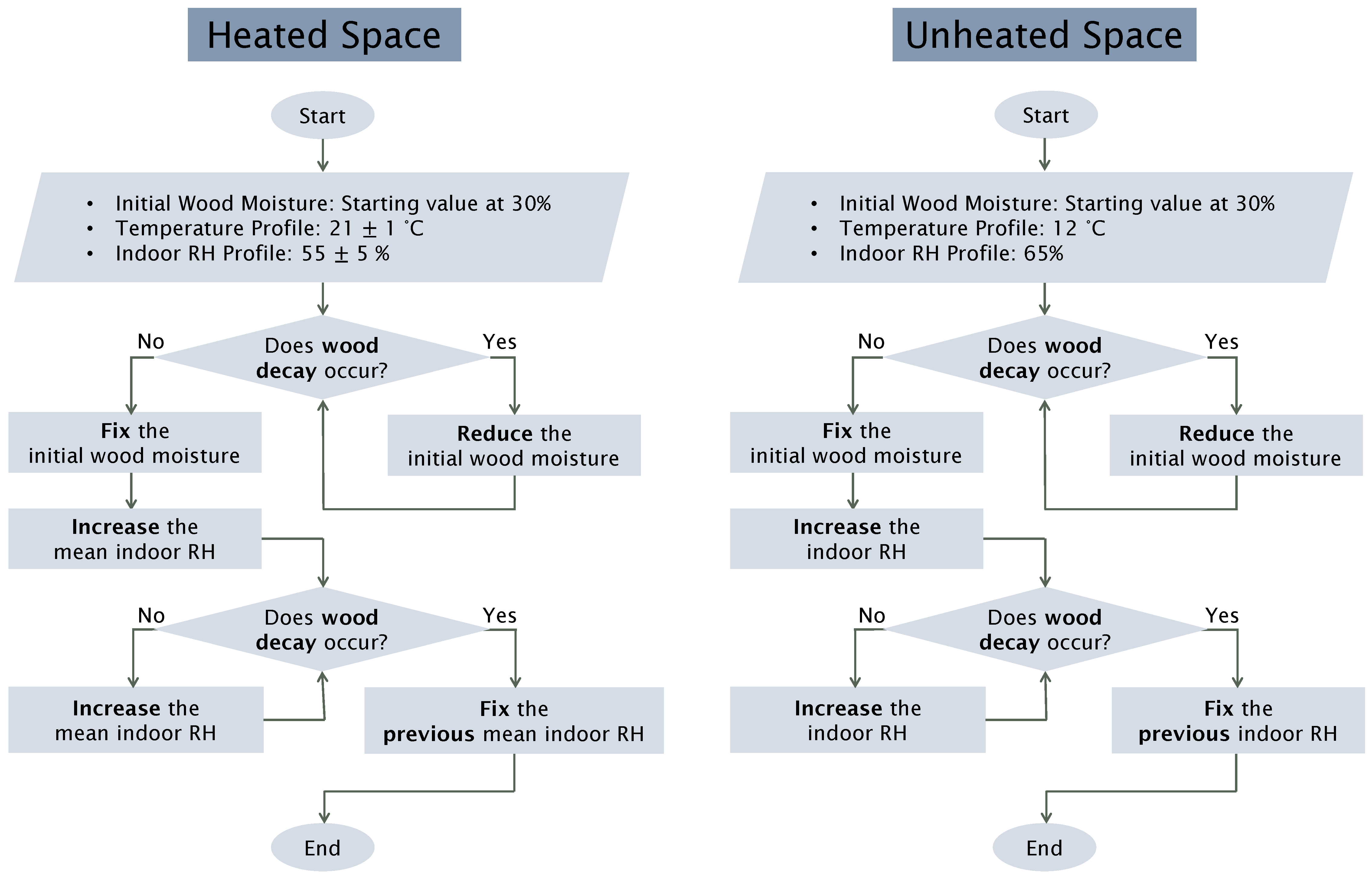
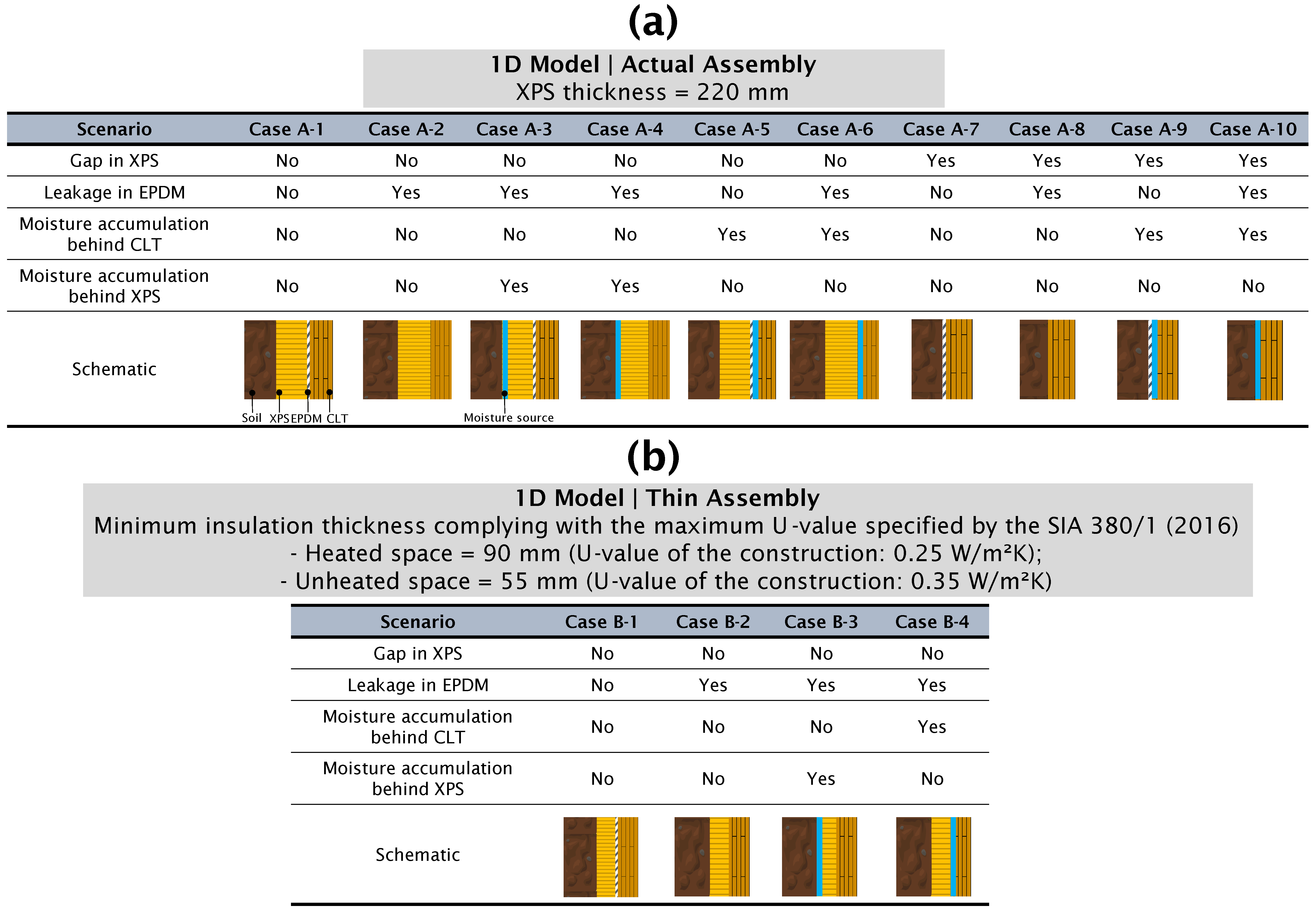

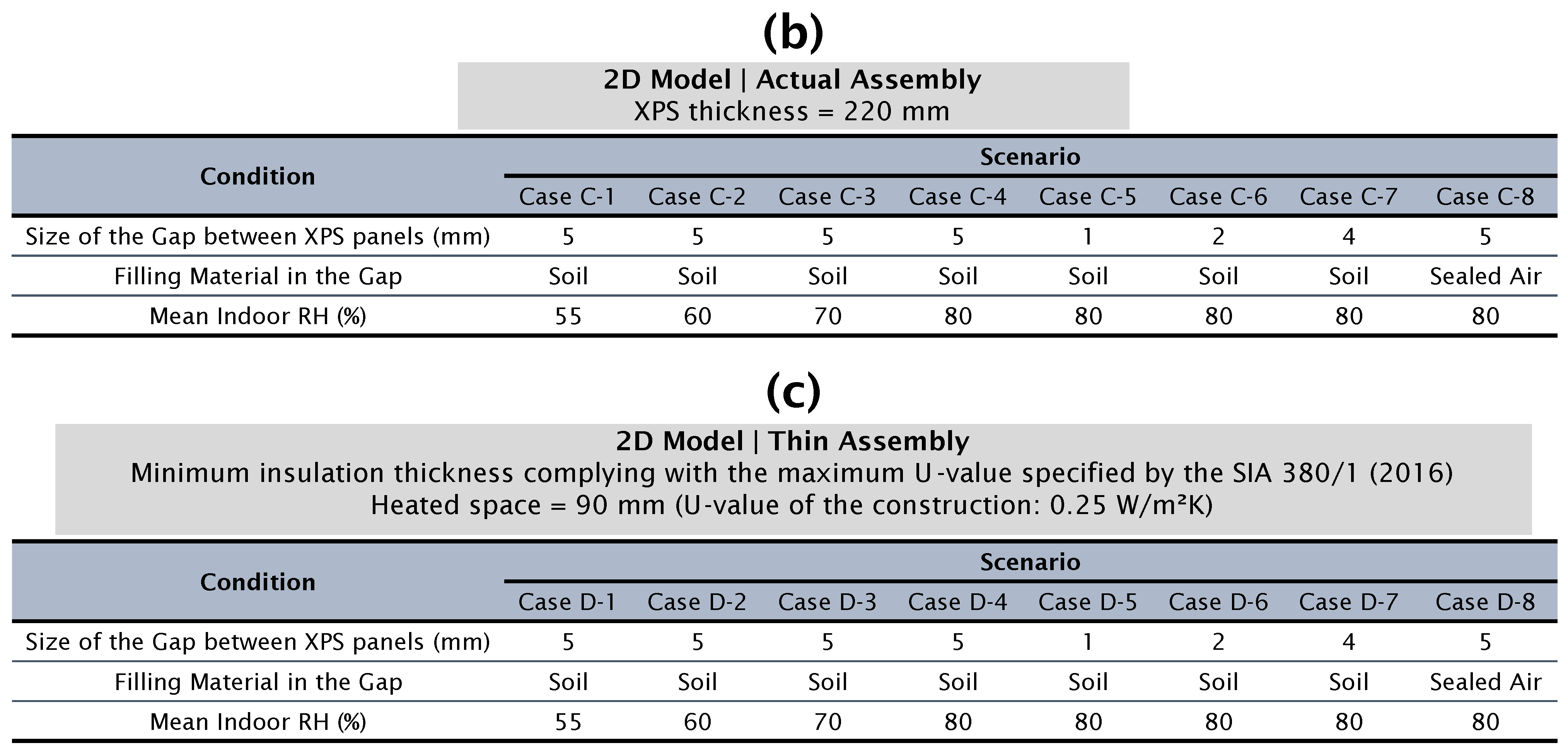




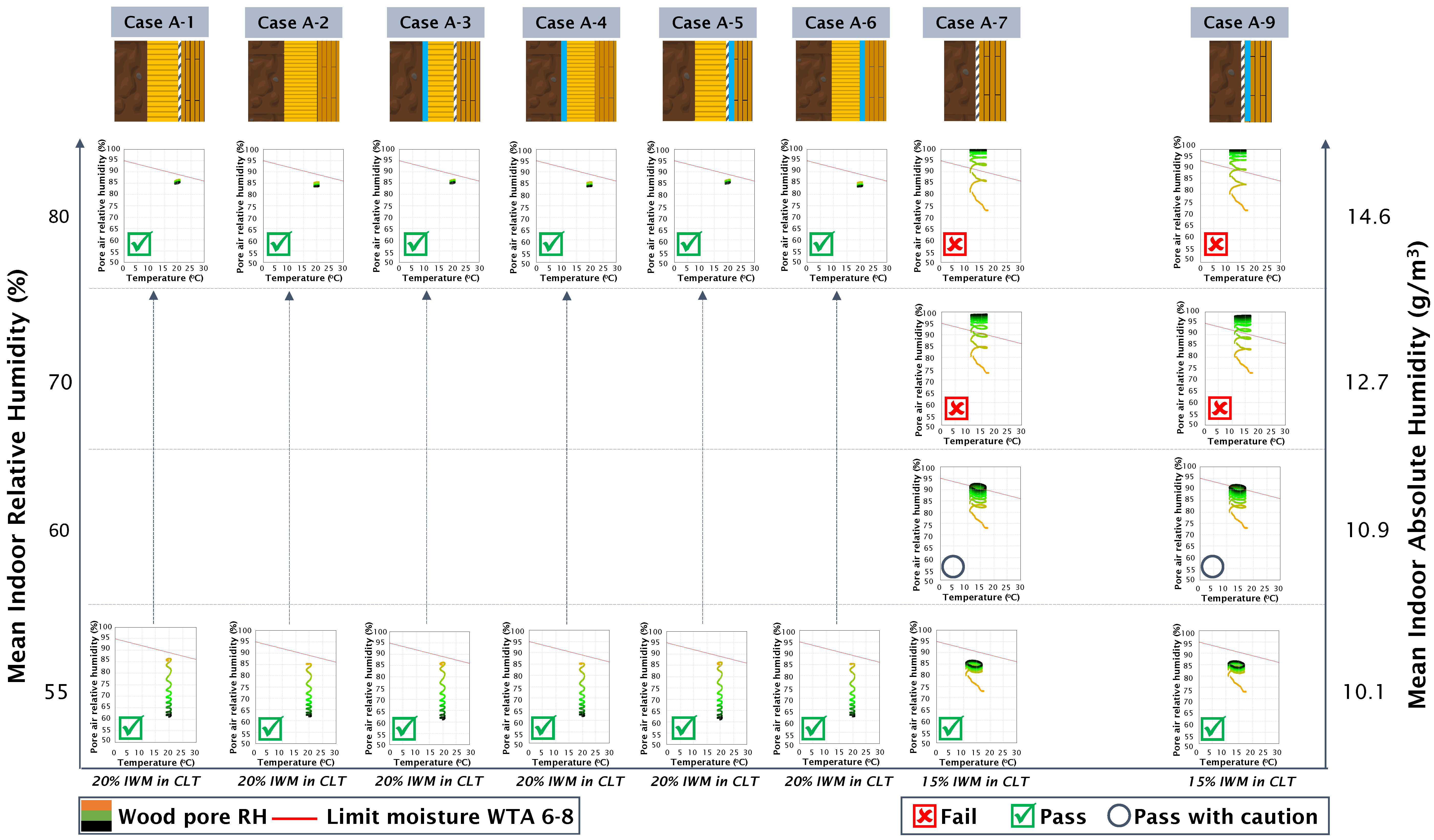
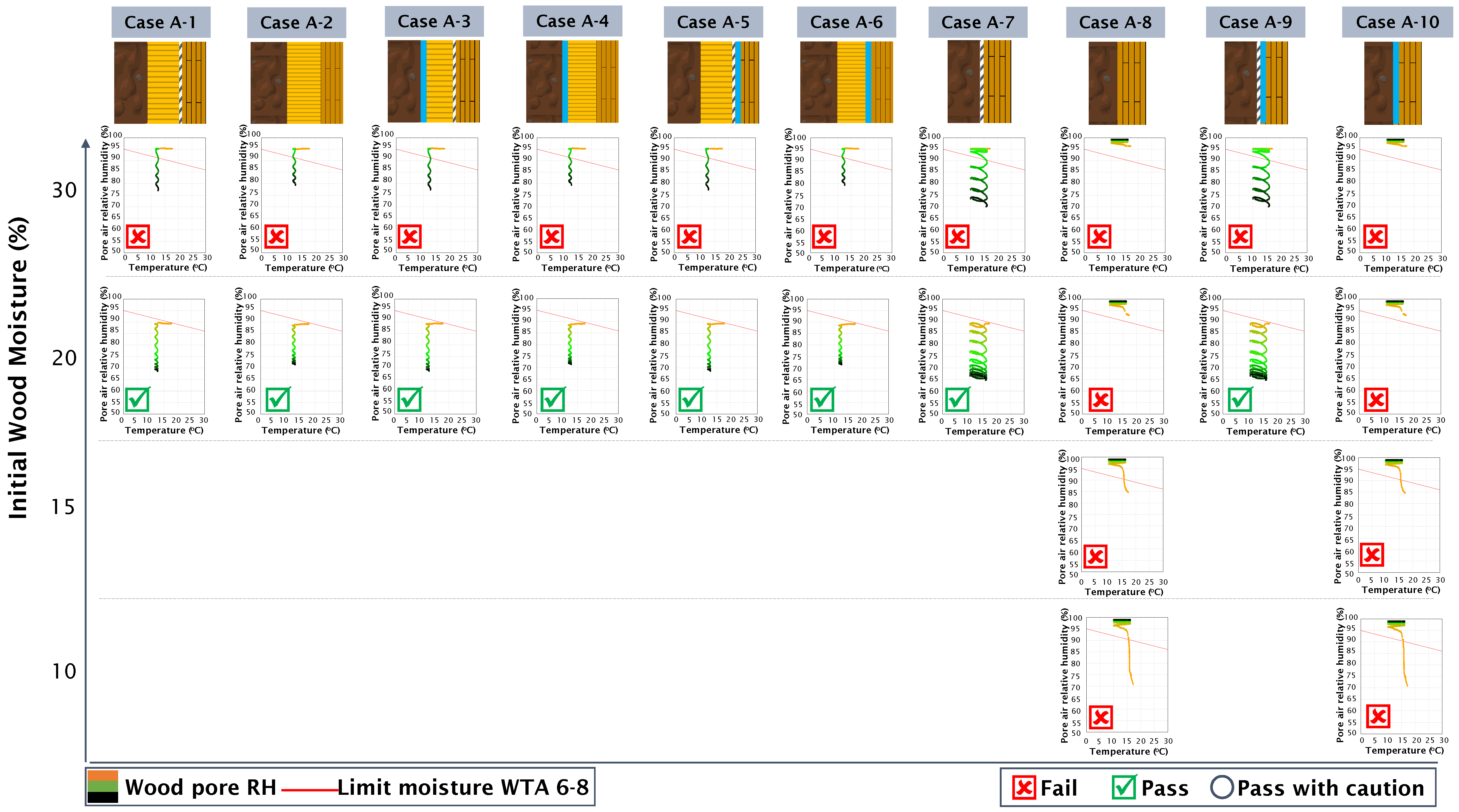
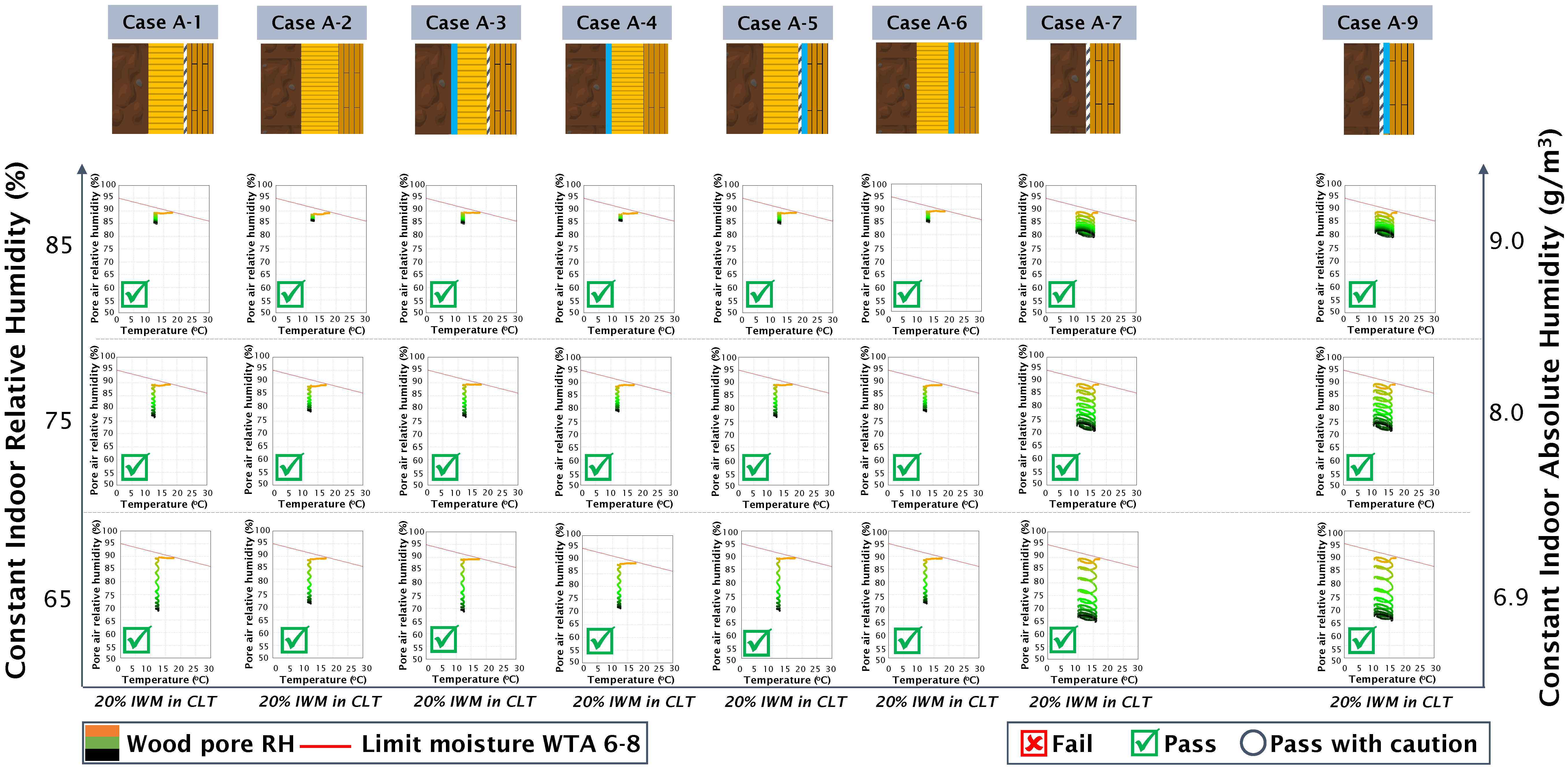
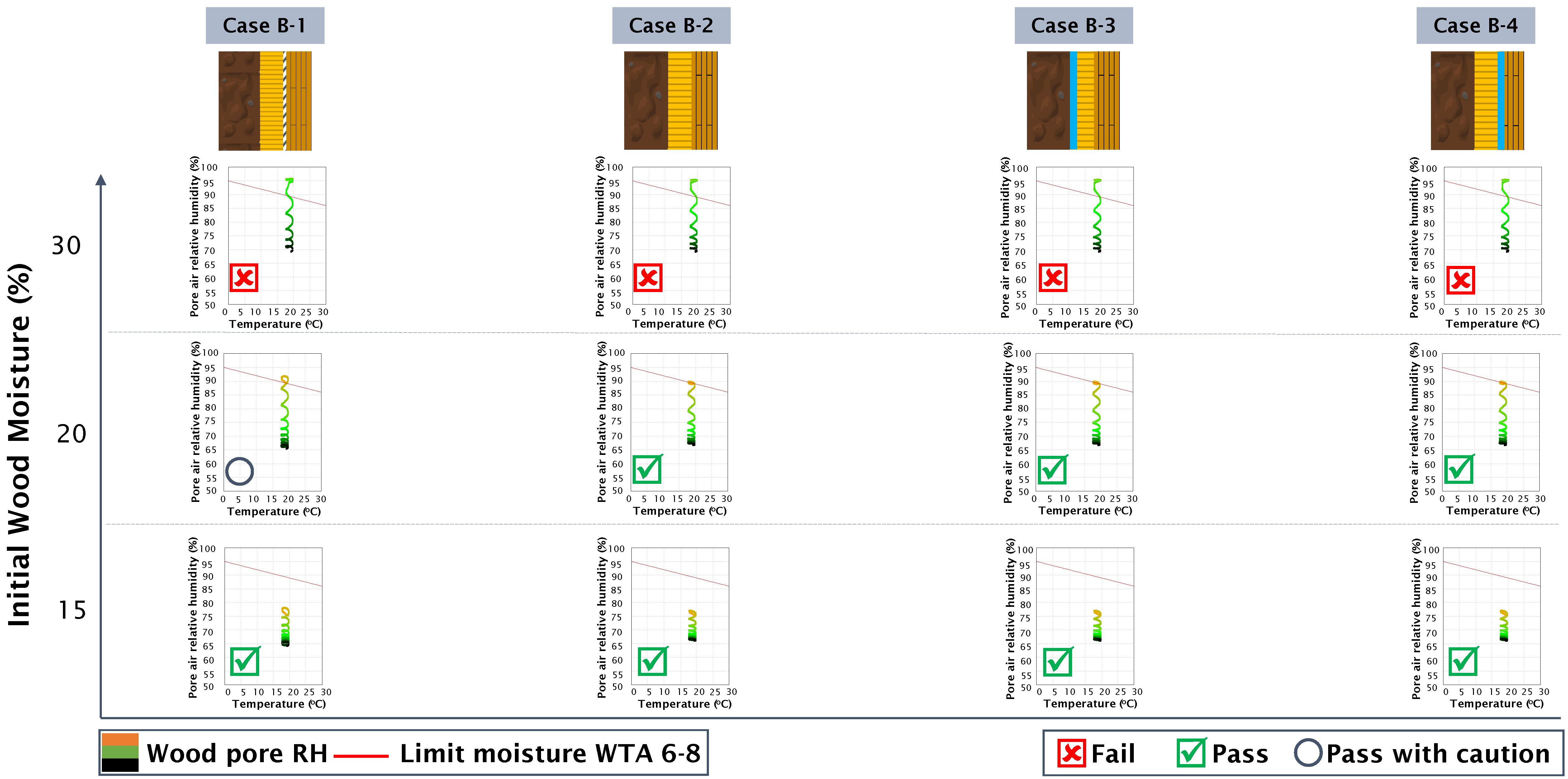

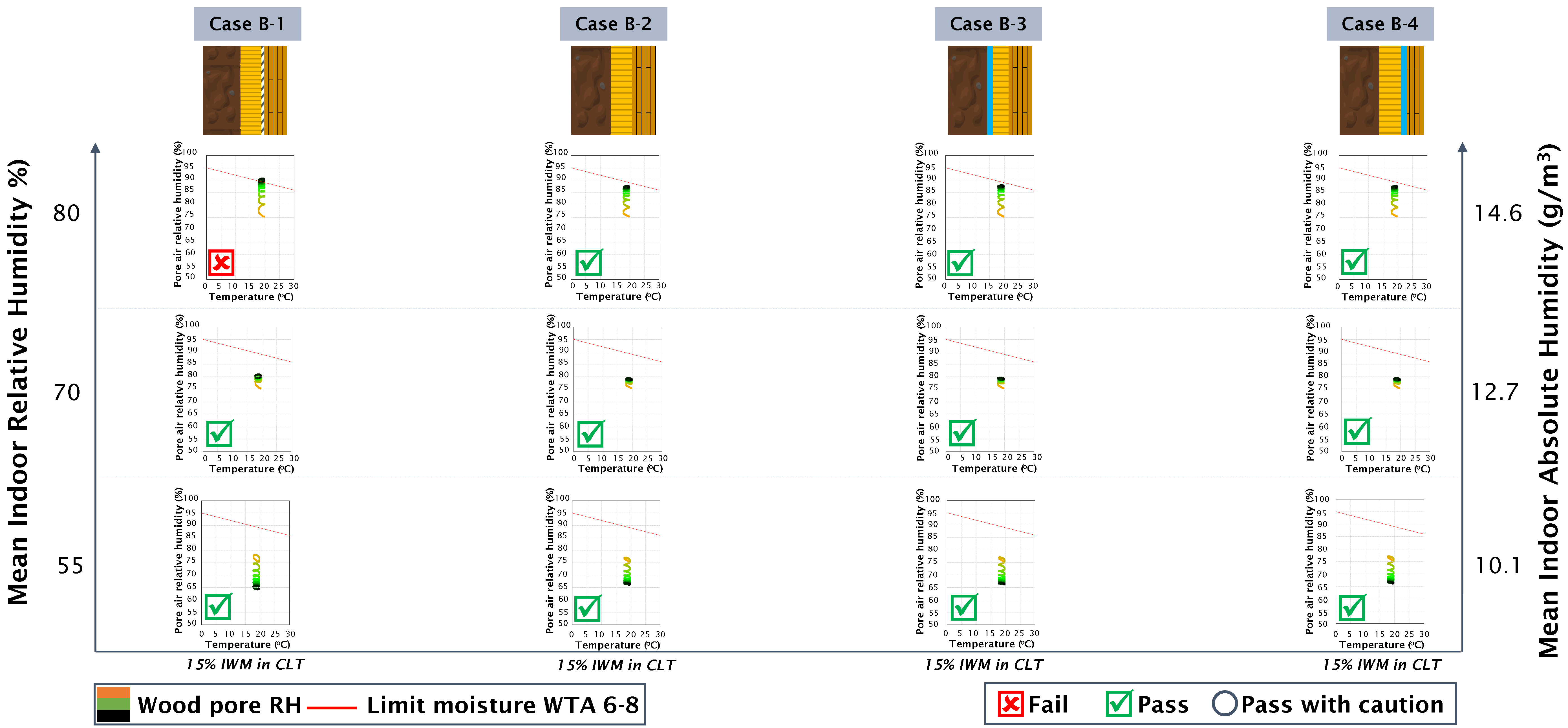
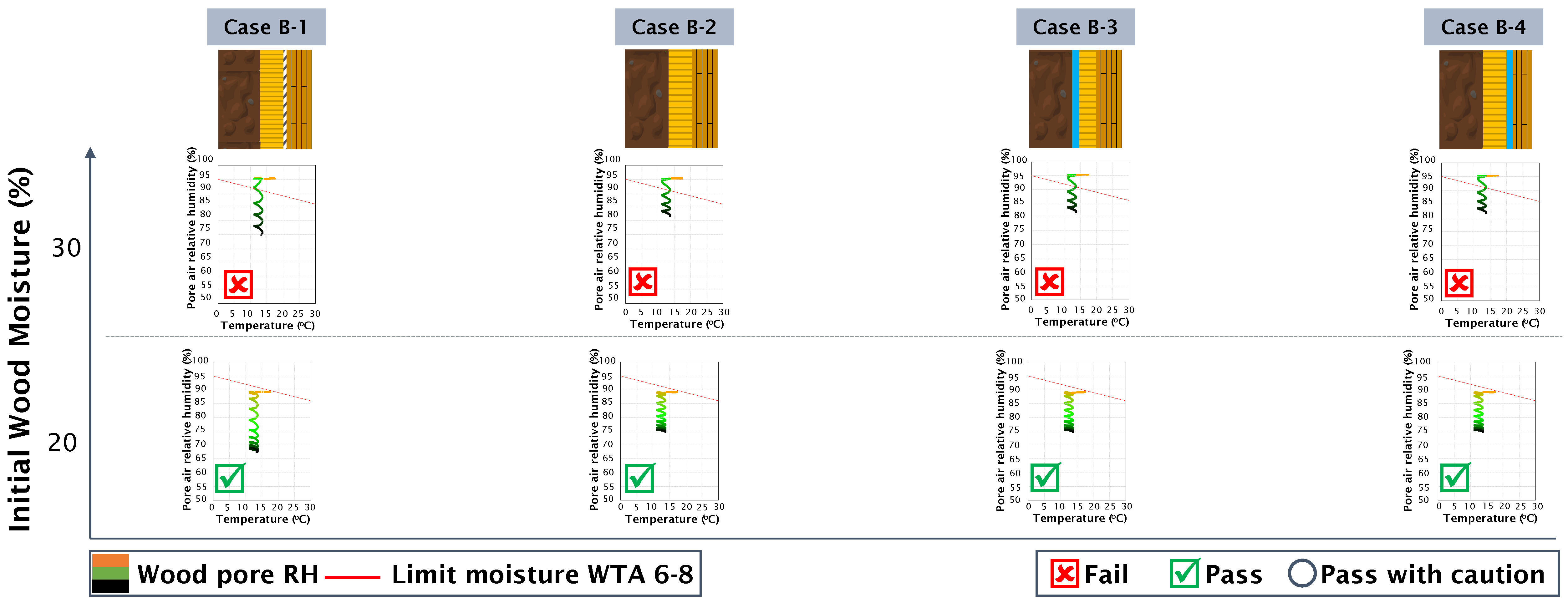
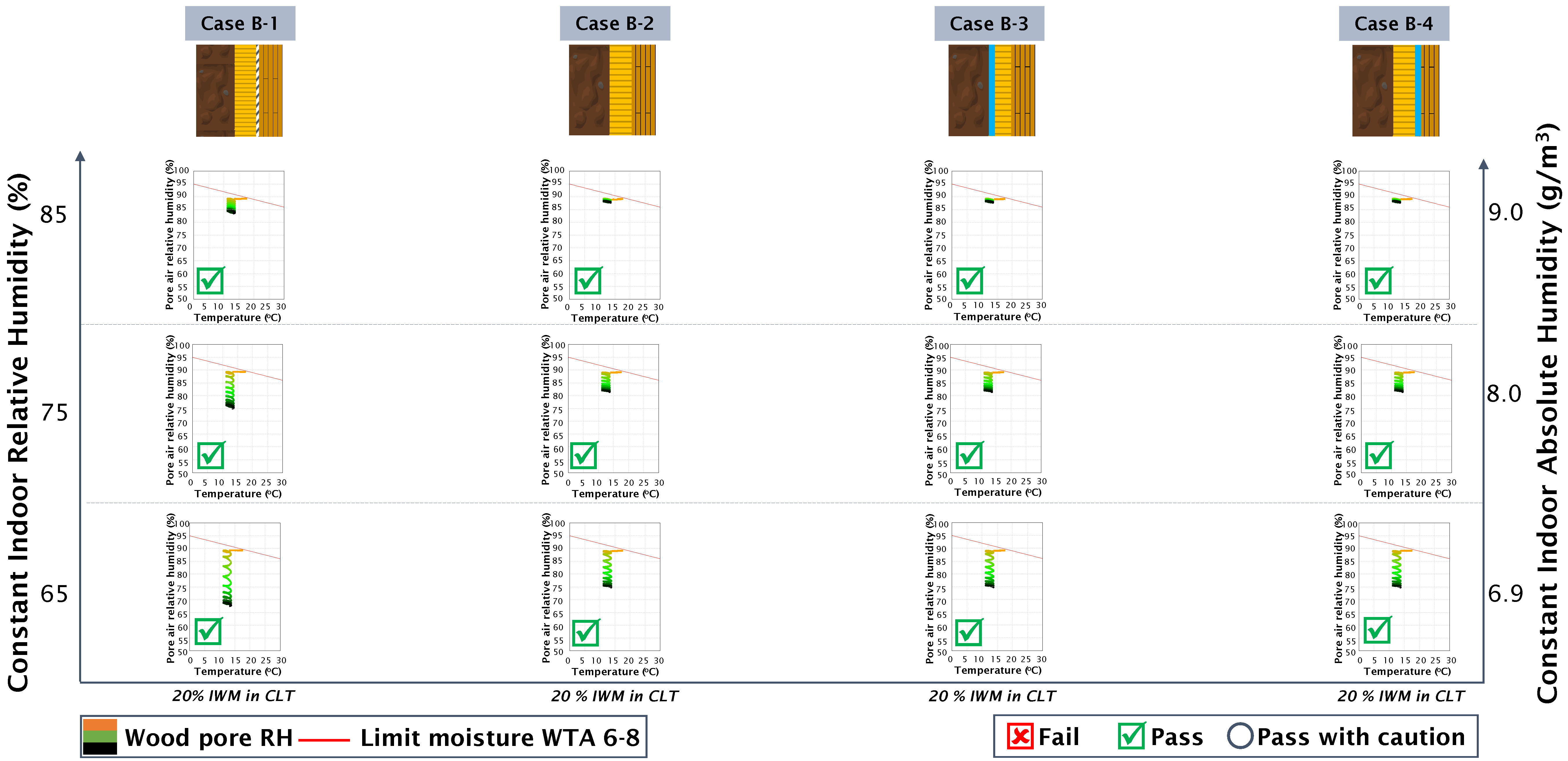
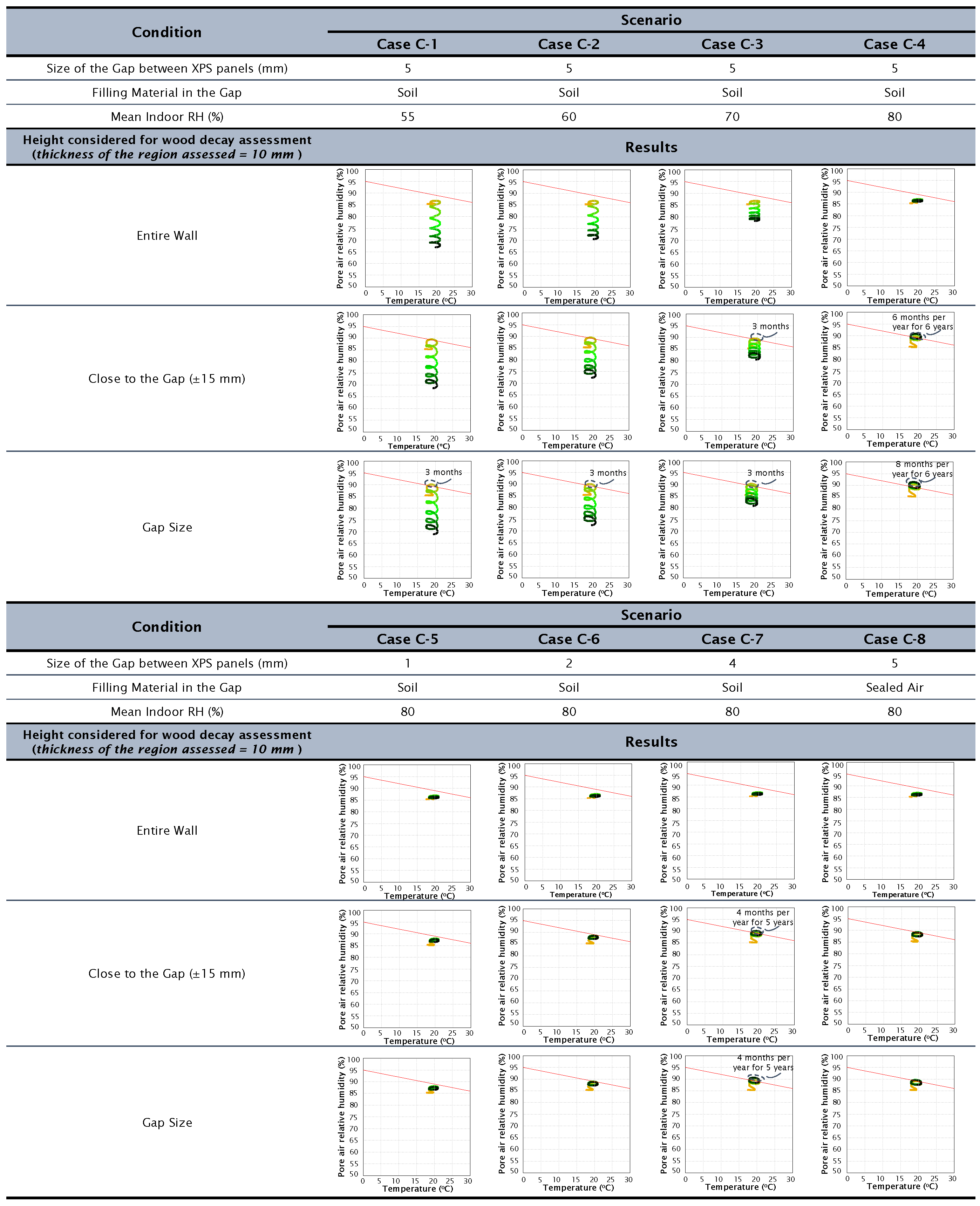
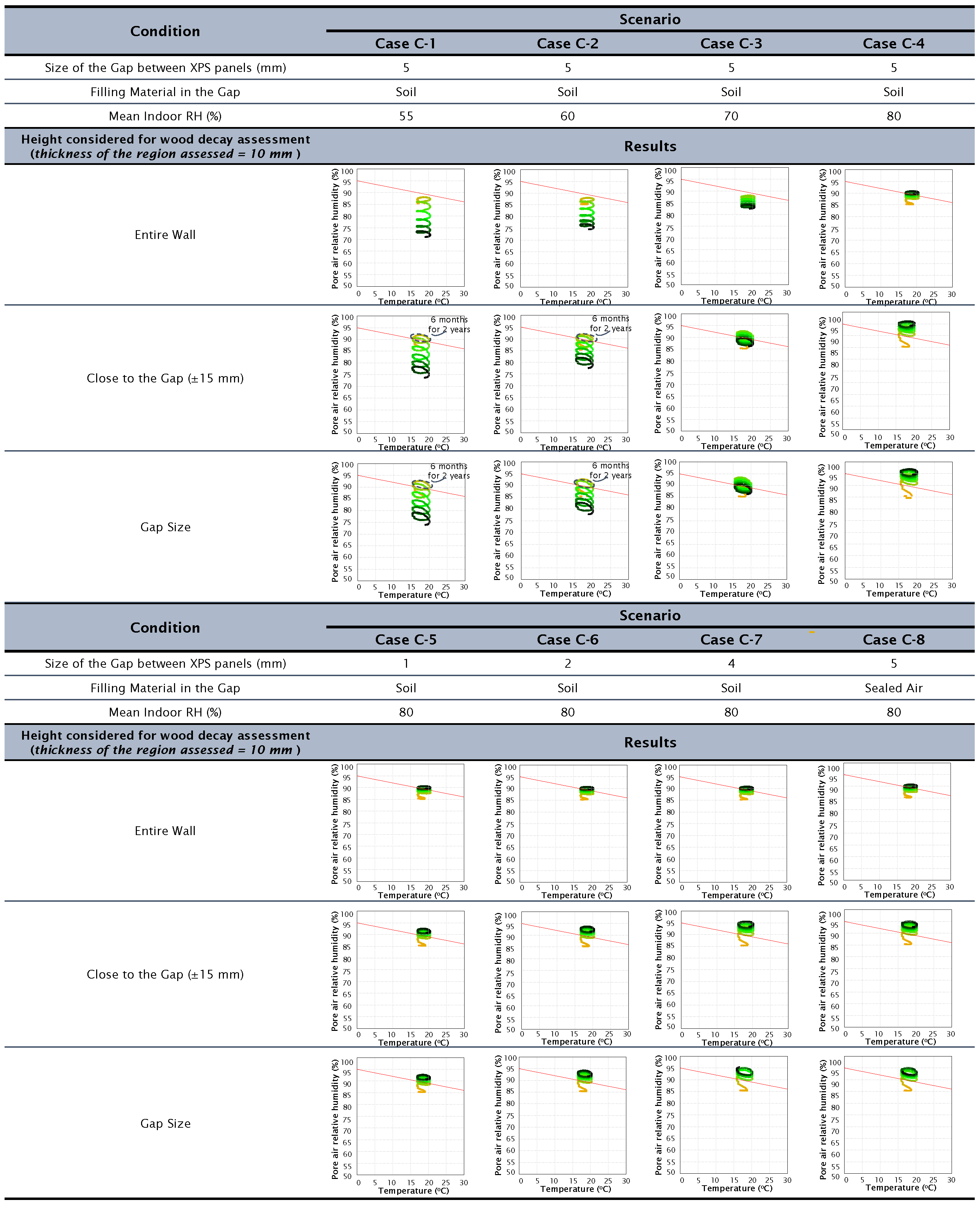
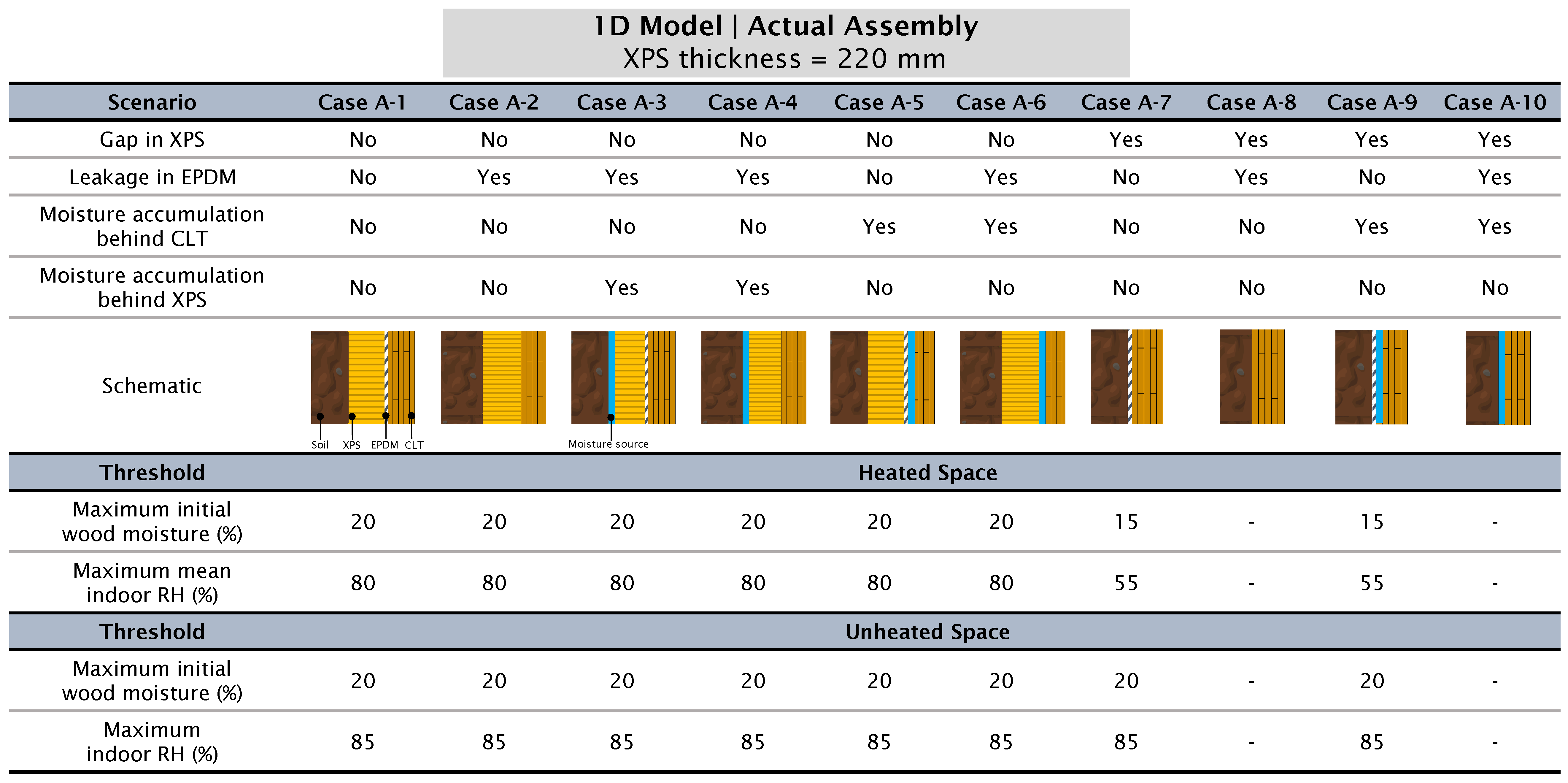
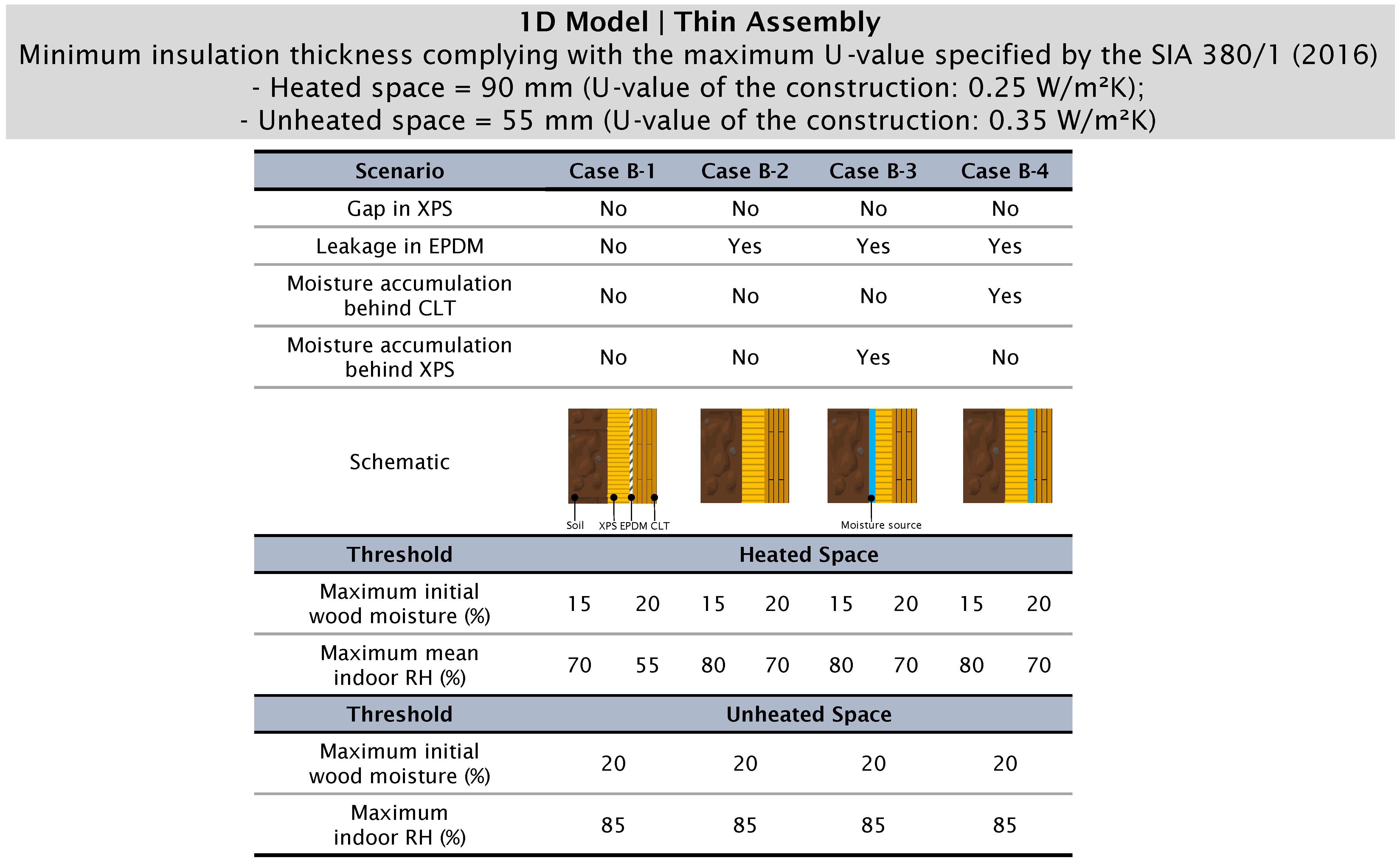
| Material | Density [kg/m3] | Specific Heat Capacity [J/kg·K] | Thermal Conductivity [W/m·K] | Water Vapor Diffusion Resistance Factor (μ-Value) [-] |
|---|---|---|---|---|
| CLT (Stora Enso) | 380 | 1600 | 0.12 | See Table 3. |
| EPDM | 130 | 2300 | 2.30 | 54,545 |
| XPS Skin | 30 | 1404 | 0.03 | 450 |
| XPS Core | 30 | 1404 | 0.03 | 165 |
| Soil | 1287 | 850 | 0.40 | 50 |
| Gravel | 1400 | 1000 | 0.7 | 1 |
| Relative Humidity (-) | Water Vapor Diffusion Resistance Factor μ [-] |
|---|---|
| 0 | 463 |
| 0.18 | 252 |
| 0.25 | 176 |
| 0.63 | 48 |
| 0.71 | 31 |
| 1.0 | 29 |
| Hygroscopic Region (Bonifacio [36]) | Capillary Region (WUFI® Database) | ||
|---|---|---|---|
| Relative Humidity (-) | Water Content [kg/m3] | Relative Humidity (-) | Water Content [kg/m3] |
| 0.0000 | 0.0000 | 0.9500 | 98.430 |
| 0.2000 | 26.010 | 0.9900 | 160.00 |
| 0.3500 | 33.400 | 0.9950 | 197.00 |
| 0.5000 | 38.650 | 0.9990 | 297.00 |
| 0.6500 | 47.460 | 0.9995 | 344.00 |
| 0.8000 | 65.490 | 0.9999 | 449.00 |
| 0.9000 | 85.440 | 1.0000 | 678.00 |
Disclaimer/Publisher’s Note: The statements, opinions and data contained in all publications are solely those of the individual author(s) and contributor(s) and not of MDPI and/or the editor(s). MDPI and/or the editor(s) disclaim responsibility for any injury to people or property resulting from any ideas, methods, instructions or products referred to in the content. |
© 2024 by the authors. Licensee MDPI, Basel, Switzerland. This article is an open access article distributed under the terms and conditions of the Creative Commons Attribution (CC BY) license (https://creativecommons.org/licenses/by/4.0/).
Share and Cite
Rahiminejad, M.; Ghazi Wakili, K.; Barat, A.; Renfer, C. Hygrothermal Performance Analysis of Wooden Basements under Critical Conditions. Buildings 2024, 14, 2222. https://doi.org/10.3390/buildings14072222
Rahiminejad M, Ghazi Wakili K, Barat A, Renfer C. Hygrothermal Performance Analysis of Wooden Basements under Critical Conditions. Buildings. 2024; 14(7):2222. https://doi.org/10.3390/buildings14072222
Chicago/Turabian StyleRahiminejad, Mohammad, Karim Ghazi Wakili, Antoine Barat, and Christoph Renfer. 2024. "Hygrothermal Performance Analysis of Wooden Basements under Critical Conditions" Buildings 14, no. 7: 2222. https://doi.org/10.3390/buildings14072222
APA StyleRahiminejad, M., Ghazi Wakili, K., Barat, A., & Renfer, C. (2024). Hygrothermal Performance Analysis of Wooden Basements under Critical Conditions. Buildings, 14(7), 2222. https://doi.org/10.3390/buildings14072222








